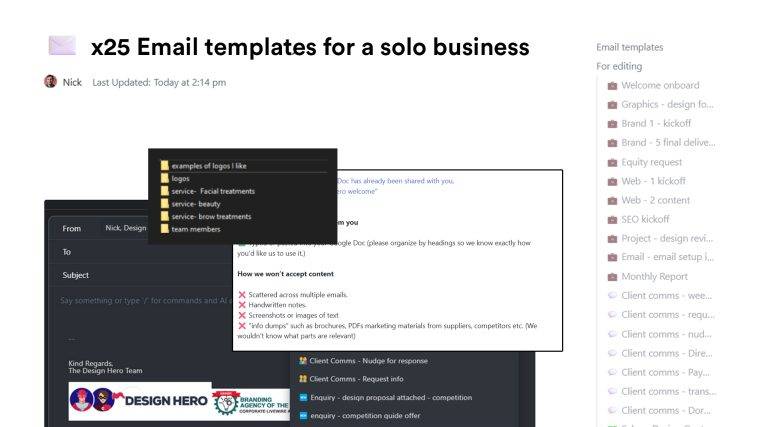Today, one of my team asked me a one million pound question;
It was one of those sticky situations that comes up in a freelance business;
the kind of situation that writes off your whole day to resolve,
plus keeps you up all night worrying about the outcome.
Every freelancer has experienced this at least once.
This kind of situation requires an awkward conversation,
and setting some healthy boundaries for your freelance business.
It requires what I call a “tricky email“.
I used to think I was good at “tricky emails”.
I used to waste hours, sometimes days, drafting long formal emails that looked like they were written by lawyers.
I thought this gave me authority and “covered all the facts”.
I would draft, edit, reword, cross-check and over analyze a single email,
then ask my wife to do the same for me.
I can think back to every time I’ve sat at my desk drafting long concise, emails.
My outrage would build as I wrote,
typing faster and faster,
until my email became a scrolling epic rage fest.
I’d then second guess every sentence,
strip out all my harsh comments,
walk it back to something more formal.
“is it too harsh?
“how do I say that without being rude?
“does that come across badly
“what if they just leave me?”
This process sapped my energy and left an emotional toll too:
- My first draft would take me hours,
- then I’d spend another hour editing,
- then I’d spend another hour rewriting it only to end up saying the exact same thing.
- then I’d spend another hour asking my wife to check how it came across.
- Plus, after I hit send, I’d spend another 2 hours worrying about it, and thinking of all the clever things I should have said
What I eventually realised is that sending long, wordy emails doesn’t help.
In fact, it only get me riled up with self-righteous anger,
and gave them more stuff to argue about 😅
Only address the main point in question, ignore the urge to respond to every tangents, and simply repeat your first point.
I’m glad my team feel like they can come to me for help with their own freelance business.
Now I can just give you the client email scripts I use, which will save hours of second-guessing and doubt.
You can skip straight to that magic feeling you get after you hit “send”,
that feeling of lightness that it’s DONE.
Now instead of overthinking I start writing,
I say what I mean to say and I get out in 15 minutes or less.
I try to keep it to 2 or 3 lines maximum
After I hit send, I don’t worry about it, I don’t think about it.
It took me a long long time to realise that the art to drafting clear emails,
that set boundaries without offending people,
is just to say what you mean,
and say it like a person.
So here’s a framework for sending good emails that solve problems, without wasting hours,
Plus I’ll dive into the actual question and the word-for-word response…
How to send boundary setting emails
- Jot down the key points.
- Stop overthinking.
- Start writing.
- Write like you speak.
- Make it clear.
- Don’t mince words.
- Only allow x1 round of editing.
- and for god sake, STOP trying to sound like a lawyer.
This last one was the hardest one for me.
I felt like using corporate speak would make it sound official.
But the formality was only throwing up walls between x2 humans.
The key to good communication with clients is just talking.
Clients like dealing with people, not corporate robots.
So today, when one of my freelancers asked me this question,
I started tapping out exactly how I’d respond, word for word.
I realised how many freelancers out there are stressing out over how to respond to these situations,
and I knew this deserved more.
Here’s my response in full:
Oh by the way Nick, may I ask something, so I have this old client who just got back to me. Basically my task for him is Linkedin carousel posts. I already did work for him before he even paid the invoice, now he’s asking for another work already and hasn’t paid the invoice. How do you approach this kind of stuff? haha. I’m just not so used to this kind of situation lol
Hey man, set a boundary now, before it becomes an issue.
once you’ve set a policy, it’s simple. it’s clear the client knows what to expect.
Problems occur when you change how things work without reason.
So generally, always avoid doing work before the invoice is paid.
If you have been working with clients for a long time, working on trust is sometimes acceptable.
But if it’s a new client, or if it’s one-off work,
you should always receive payment before starting the work.
Here’s a simple line that explains how this works to the client without objection:
“Hey Jane, Look forward to working on this for you, I’ve attached the invoice for the work, I’ll get a notification once paid, and as soon as it’s cleared I’ll add this to the work queue for you and get started.”
This clearly communicates you expect the payment before you start the work,
and that the timeline of the project depends on them making the payment,
and that the ball is in their court.
Obviously, this doesn’t help you right now since you’ve already done the work, and sent it to the client,
Therefore you have no leverage.
So for your particular situation…
Here’s a script of what I’d say exactly:
“Hey X, great look forward to working on this for you,
There’s an outstanding invoice we have to clear first before we can start the new job, I’ve attached it for you. Can you please square that up for me by the 21st, then I’ll start on the 2nd job, which I hope to have completed by the 24th. Thanks, appreciate the new work .🙂” (you can change the dates and amounts.)
But I’d actually take an alternative approach…
If you’re going to be doing regular work for him or her I would recommend pitching a retainer from the start.
Retainers bring you stability, and predictability, and save you a lot of admin time drafting invoices and quotes for each small job.
Here’s a script I’d use to pitch a retainer.
“Thanks for sending me more work! If your happy with the first carousel,
For carousels I normally work on a retainer basis for X no of carousels per month at £Y,
This works out slightly cheaper for you than doing it ad-hoc,
Since I don’t need to quote you for each new carousel.
Would you like to set that up and I can get started?”
Here’s a resource on how to shift to retainers as a freelancer
Bonus tip:
Always have a way to instantly take payments via a link, such as GoCardless or Stripe etc.
If someone wants to give you money, make it easy for them, before they get distracted.
So there’s your options:
- Ask him to settle up before you proceed.
- Shift him onto a retainer model
- If you can’t get him to go on a retainer, make sure you transition to payment upfront from here on in.
- And if both of the above fail, make sure you do not proceed with more work until the first invoice is settled.
The responses to the above will indicate if you are likely to have future problems with this client.
Always give the benefit of the doubt to people the first time they miss an invoice.
Business owners are busy people.
often they get distracted or miss the email or just forget.
But reasonable people who intended to pay will respond reasonably.
Unreasonable people, who intend to scalp, or leverage you, will not respond well and will try to hold out to manipulate you.
If this helped you at all,
subscribers get instant access to 25+ boundary setting email templates for freelancers

Setting healthy boundaries doesn't have to be hard.
Subscribe for instant access to x25 foolproof email templates to set boundaries as a solo business.
















